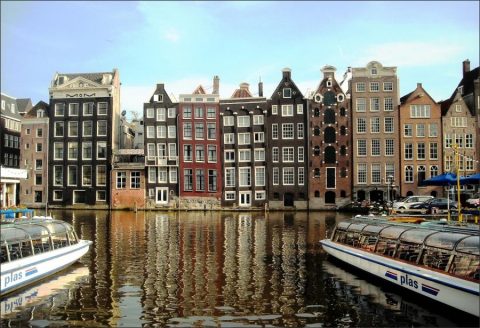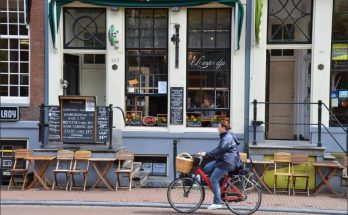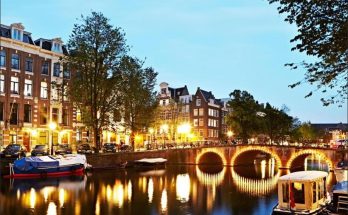There are few other places in the world that have been so involved in international trade and communications for as long as Amsterdam has. In its golden age Amsterdam was the prototypical model of the world city of mercantile capitalism and it has survived various phases of formation and reformation to remain among the higher ranks of contemporary world cities (Soja 1993: 85). Yet, despite the willingness to compete internationally, it is by no means certain that the city will prosper as an international city in the future as it has in the past.
There will be more Amsterdam-like cities in the Europe of the future and the competition will intensify, not only among the major cities in Europe but also among the emerging regional centers that prosper within the national economies ( O’Loughlin 1993: 25). Although Amsterdam is still perceived as the symbol of national culture — the city is called the cultural capital of the Netherlands — it must compete in the cultural and economic arena with other large cities in the Randstad ( Rotterdam, Den Haag, Utrecht), and more recently with Maastricht in the south. Both the national and global competition account for the recent revitalisation of the city.
The strained municipal budgets in the 1990 s seem to have shifted the focus of urban development towards transforming Amsterdam into a tourist metropolis. In the tourist policy of the 1990 s much stress has been put on historical themes such as the Golden Age ( 1993 /94), Van Gogh ( 1990), Rembrandt ( 1992), and Mondriaan ( 1994), which have been supported by impressive expositions and manifestations. However, there is a widening gap between the institutions responsible for the city’s tourism policy (i.e., the local government), on the one hand and the Amsterdam Tourist Board on the other.
To enhance the reputation of Amsterdam as a centre of culture, the Tourist Board wished to promote not only the museums, canals, and famous buildings, but most importantly the city’s historically close link to the sea and trade (VVVAmsterdam 1993). Thus, the Tourist Board campaign presents Amsterdam as a Zuider Zee fishing village which became the capital of a seafaring nation and trading empire ( Amsterdam Tourist Board 1993, 8: 1-2), a history that has generated today’s liberal atmosphere, another important asset in the Tourist Board’s promotional activities (ibid. 1993, 12: 5), as is the significance of the hippie mecca of the 1960 s for modern popular culture (ibid. 1993, 9: 7) and global youth culture (ibid. 1993, 10/ 11: 1-2).
More recently, the Tourist Board started a campaign in the United States highlighting ‘ Amsterdam, the Gay Capital of the World’, a campaign that had to be cancelled after protests from the Amsterdam tourism industry, which feared it would scare off other, more conservative target groups. The local government, however, is not supportive of the idea of promoting the liberal atmosphere, the youth culture, and the 1996 s, as these themes attract target groups different from the tourist categories that the city council prefers.
The bureaucrats do not want to encourage any further growth in the number of tourists visiting Amsterdam. They do however, want to encourage tourists to spend more money, stay longer, and cause less trouble. The governmental policy is aimed at attracting more middle-aged, well-educated and well-to-do tourists ( Amsterdam Toeristenstad 1989, Amsterdam Tourist Board 1993, 12: 5). Young backpackers and touring-car transported mass tourists will have to give way to cruiseship passengers adding allure to a revitalised harbour ( De Volkskrant, 30-11-93).
Tourists — foreign and domestic alike — are curious to see Amsterdam’s picturesque Golden Age setting and its present-day residents. The representation of the city of Amsterdam as a tourist attraction is characterised by a mixture of cultural fragments of past and present, the traditional and the modern, the elite and the popular, the local and the global. The tourism industry is capitalising on the city’s glorious past, the display of ‘high culture’, scenes of everyday life, and the ‘rough’ edges of the downtown area.
The image of Amsterdam as a tourist city is based on two major themes. The first is the image of the city being dominated by the urban town design of the early modern period. Visitors have clear expectations of Vermeer townscapes composed of tightly packed canalside buildings. As a tourist site Amsterdam is characterised by a physically compact and thematically cohesive inner city.
The touristic resources within this area depend upon an urban ensemble from the seventeenth and eighteenth centuries, and serve a show-case function, which is supported by entertainment facilities of a national and international reputation ( Ashworth and Tunbridge 1990: 181-183). The second is the current popular image of Amsterdam, which was formed in the late 1960 s and is based upon a youth culture of sexual liberalism and narcotic indulgence. More recently this image has been strongly linked to a ‘dirt and disorder reputation’. Amsterdam has been presented by the international media as the city of vandalism, insecurity, and lack of public order (ibid.).
This image of ‘history, heretics, and whores’ is not detrimental to tourism; it has on the contrary become the major attraction of the city. As recent research on the image of Amsterdam among visitors has shown, 78 percent of the tourists are attracted to the city because of cultural-historical aspects, i.e., museums and exhibitions, and more than 50 percent because of the liberal atmosphere ( Amsterdam Tourist Board 1994, 2: 6-7). The tourist industry is aware of this.
Almost all city guides to Amsterdam mention the interweaving of different strands of life that constitute the city’s attractiveness: the reminders of the wealthy Golden Age trading city dominated by a few Calvinist families, the sleazy port, the remnants of a proud maritime nation and affluent colonial empire, the reputation of tolerance and liberalism, the rich bourgeois culture, the radical hippie mecca of the 1960 s grown comfortably liberal, and the red-light district.
Some tourist guides (for example, the Rough Guide) mention the drug dealing and the gay scene. References to ‘national’ and ‘global’ history go hand-in-hand with local images of the past, tales of the vicissitudes of ordinary people and scenes of everyday life. The cultural diversity reflected in the tourist images takes shape in local discourses.



